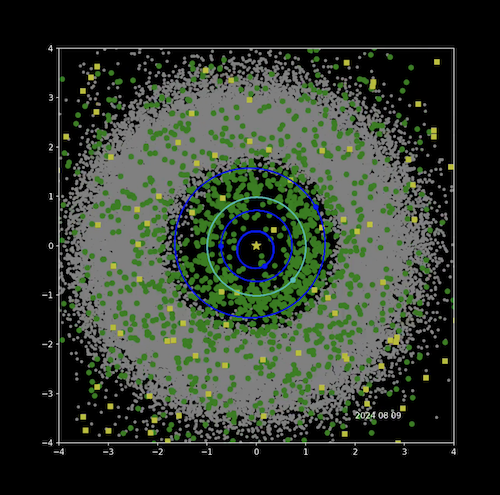
November 14, 2024
The Near-Earth Object Wide-field Infrared Survey Explorer (NEOWISE) and IPAC at the California Institute of Technology announce the NEOWISE Final Data Release.
The Final Data Release includes data acquired during the eleventh year of the NEOWISE Reactivation mission (Mainzer et al. 2014, ApJ, 792, 30), 13 December 2023 to 1 August 2024. These data are combined with data from the first ten years of NEOWISE mission into a single archive that contains ~26.9 million sets of 3.4 and 4.6 micron images and a database of ~199 billion source detections extracted from those images.
NEOWISE scanned the sky over twenty-one complete times during its 10.6 years of survey operations, with approximately six months between survey passes. Twelve or more independent exposures are made on each point of the sky during each survey epoch making the NEOWISE archive a time-domain resource for extracting multiple, independent thermal flux and position measurements of solar system small bodies and background galactic and extragalactic sources.
A guide to the NEOWISE data release, data access instructions, and supporting documentation are available at http://wise2.ipac.caltech.edu/docs/release/neowise. Access to the NEOWISE data products is available via the on-line and API services of the NASA/IPAC Infrared Science Archive (IRSA) at https://irsa.ipac.caltech.edu.
NEOWISE is a joint project of the Jet Propulsion Laboratory/California Institute of Technology and the University of California, Los Angeles, funded by the National Aeronautics and Space Administration Planetary Science Division.
This top-down view of the Solar System shows the positions of all asteroids and comets detected by NEOWISE during the Reactivation Mission, which concluded operations on August 8, 2024.
The blue circles and points indicate the orbits and locations of Mercury, Venus and Mars. The Earth and its orbit are shown in cyan. Filled gray circles are Main Belt asteroids, filled green circles are Near Earth asteroids and the filled yellow squares are comets.
The white points indicate the objects NEOWISE detected during the last week of surveying. The tick marks on the x and y axes are in increments of 1 AU. This animation shows how solar system object detections accumulated over the course of the survey. The white points show the new detections from each successive run of the WISE Moving Object Pipeline System, and illustrate how the NEOWISE scan longituded progress around the sky.
Credit: Tommy Grav (Univ. of Arizona)